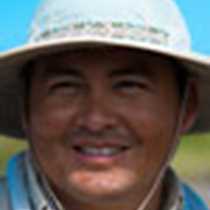Isabela Island
The adventure continues in the Galápagos Islands. The emblematic and prehistoric creatures that gave the name to the most pristine islands in the world, the Galápagos tortoises, were sighted today. We spent all day in one of the largest islands in the archipelago; Isabela Island with an area of 4,640 square kilometres (1,790 sq mi) make up just over half the total surface area of the archipelago.
We began our morning outing with a wet landing over a black sand beach; over time the rusted black lava that is characteristic in an oceanic volcanic island broke down by the interaction with the elements such as wind and water. In the present day, this beach is used for Pacific green sea turtles as a nesting ground. The clear and calm water of Urvina Bay allowed us to see a firsthand penguins and flightless cormorants chasing small fish that were in the area. Once we all were ready; we explored the interior of Urvina with very high expectations; our patience paid off, since we were in complete silence it was easy for us to hear a giant tortoise that was approaching to us. Like a war tank the huge reptile was opening its own path through the dense vegetation. The Galápagos tortoise weighed at least 400 hundred pounds. Further along the trail we spotted land iguanas that have been reintroduced into the Isabela Island in the last twenty years through the efforts of the national park breading center. Isabela is also interesting for its flora that supports a varied life. For example, finches, mockingbirds, and cuckoos. The morning ended with a refreshing swim at the same beach where we’d desembarked.
The coatsline of Isabela Island is well known for its geology, providing excellent examples of a geologic occurrence that created the Galápagos Islands. Tuff cones at Tagus Cove are unique; the features are well shaped by the winds creating a bizarre landscape. In the afternoon our guests had different choices to enjoy once more the beauty of Galápagos. Kayacking was chosen by explorers who wanted a close perspective of the volcanic features and wildlife of the coastline and others explored the underwater realm. A power hiking with a beautiful view of Darwin’s Lake was chosen by very active people while other enjoyed a Zodiac ride. Each of the activities in the afternoon delighted our guests.
At the end of the day we all gathered on the skydeck to enjoy a fresh Galápagos cocktail. As the sun was setting we all shared so of the unique moments of the trip, such as a male sea lion that we saw at the end of the snorkeling eating a 20-pound yellowfin tuna. Soon after the sky grew completely dark, the stars begin to show up. A few contelations were possible to point out from our current location. The most asked constelation among our guest was the Southern Cross. Another day in paradise fulfills our understanding of what natural selection and survival of the fittest are all about.




